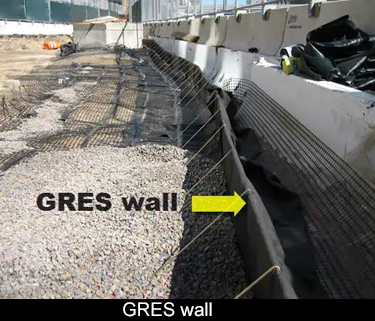This is a good overhead view in the area where the underground connector is going to be constructed. I just want to sketch that in for you. The underground connector will be constructed in this area.
Obviously, it cannot be built under the existing pavement. The solution is to shift the roadway as much as possible to create an open workspace where the underground connector can be constructed. What you see here is an area of temporary asphalt being prepared to shift that traffic. With the temporary asphalt in place, the six lanes of existing traffic can be shifted as far to the West as possible. The shift will occur one lane at a time, so you probably would put one lane in service. After that, you can put the second lane in service.
If the new temporary asphalt is at the same elevation as the existing roadway, it's fairly straightforward to move the lanes over. On this project, there were always differences in elevation and they had to be accounted for. Very often you'd have to shift it a lane at a time and then make some adjustment to the difference in elevation, in order to shift the next lane That often required that the work be done at night, or the work could also be done over a long weekend. In the absence of that gray difference, the shift could take place rather quickly, probably one evening shift would be enough, but given the complexity of adjusting the grades, you need to shift the lane at a time. You may need to reduce the number of lanes in service and the slow hours of the weekend would be the best time to try to do that.
You can also see this crew beginning to lay out the concrete barrier. They are quite close to the point where they're going to open the detour. Of course, at the last minute, you need to do the striping and the striping has to be carried on to the existing pavement as well. There's a great deal going on, much of it under live traffic. To the extent that you could get an extended shut down, it just makes the transfer of traffic that much easier.
Here's another view of the same area. In this photo, that offset has been placed in service. The traffic used to be over here someplace. You can see some remnants of that roadway. After the shift, they are way off to the side. You've now created this very large workspace to construct that underground passageway. You have three lanes of southbound traffic in this new location. You have three lanes of Northbound traffic in this location, and you've cleared this big area for the construction of the underpass. At the same time, the basic construction of the new highway is taking place in this zone and off the picture to the left or to the South, that narrow band is under construction.
 The new highway is at a higher elevation than the existing. Could be as much as 6 feet higher. Raising the grade is being accomplished using a GRES wall. That's a geotextile reinforced earth system. Because the new roadway will be at a higher elevation than the existing, you need to create a support at the edge of that new construction. There will be a sharp drop off between the new and the existing. That's contained by means of this GRES wall. It's extremely effective. It goes down very quickly. It's made up of kind of a basket of wire mesh placed in combination with geotextile fabric of various sizes. It's quite effective in this project. It will be used for perhaps a six-foot height, but it can go much higher than that.
The new highway is at a higher elevation than the existing. Could be as much as 6 feet higher. Raising the grade is being accomplished using a GRES wall. That's a geotextile reinforced earth system. Because the new roadway will be at a higher elevation than the existing, you need to create a support at the edge of that new construction. There will be a sharp drop off between the new and the existing. That's contained by means of this GRES wall. It's extremely effective. It goes down very quickly. It's made up of kind of a basket of wire mesh placed in combination with geotextile fabric of various sizes. It's quite effective in this project. It will be used for perhaps a six-foot height, but it can go much higher than that.
 Now, I'm standing on the other side of the GRES wall, so that you can see its construction a little better. There are individual layers. You can see this very heavy wire mesh. The material is contained in place by means of the fabric. This is put down and lifts and goes up quickly. It really goes up as fast as you could spread the fill material and produces this excellent temporary retaining wall.
Now, I'm standing on the other side of the GRES wall, so that you can see its construction a little better. There are individual layers. You can see this very heavy wire mesh. The material is contained in place by means of the fabric. This is put down and lifts and goes up quickly. It really goes up as fast as you could spread the fill material and produces this excellent temporary retaining wall.
continue >